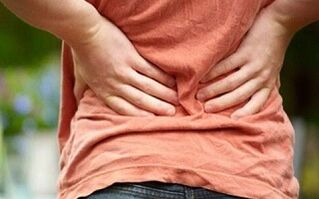
We’re sure you’ve read and heard that lumbar osteochondrosis often affects bank employees and office workers, programmers, and hard workers. That is true, but the whole truth is that today it is hardly possible to find at least one activity that does not involve the risk of developing this disease.
Why is it that? Lumbar osteochondrosis is a kind of "tax for vertical gait, " a tribute that each of us must pay to nature. The reason for the degenerative changes in the cartilage tissue of intervertebral cartilage lies not so much in the increased load on the nucleus pulposus, but in the peculiarities of the blood supply to these structures.
By about the age of twenty, the arteries that feed the fibrocartilaginous tissues of IVD during adolescence are destroyed, and for the remaining years, the nucleus pulposus and annulus fibrosus receive nutrients solely by diffusion, and that is clearly not enough! Trace elements, polysaccharides, amino acids, and other structural components enter extremely limited amounts into chondrocytes (cells that synthesize the interstitial material of the plate), creating fertile ground for the development of dystrophic processes.
In the course of our professional activity, we regularly sow seeds in this fertile soil. We sit in the wrong position, lift weights incorrectly, move a little, and spend a lot of time behind the wheel or behind a computer monitor. All other things being equal, such a form of physical activity would "get away with us, " but with a limited supply of cartilaginous structures in IVD, degenerative processes will inevitably develop.
How does lumbar osteochondrosis manifest itself?
The first manifestation of osteochondrosis of the lumbar region is pain syndrome. As a general rule, a "lucky person" first suffers from a sharp pain in his back that pierces his body with a dagger. The pain occurs after accidental twisting, tilting, or hypothermia of the trunk. Such pain cannot be tolerated - literally the man is tied with his feetand puts her to bed.
What changes occur in the spine in the background of pain syndrome? To reduce pain, the nervous system sends stimulatory signals to the deep muscles of the back. Strengthening muscle tone helps reduce mobility in the affected segment of the spine, which reduces the severity of pain for some time. In the future, myofixation will cease to provide compensatory function, and such muscle-tone imbalance will only exacerbate pain.
When examining such a patient, the neuropathologist detects signs of fixation syndrome or objective symptoms of the disease — changes in statics and dynamics. By changes in the statics of lumbar osteochondrosis is meant the flattening or increase of physiological curvature (lordosis) and the appearance of pathological curvature toward pain (scoliosis). Dynamic symptoms of the disease are a sharp restriction of mobility (until complete immobilization) in the affected segment.
All of these changes can be confirmed using spondylography (spine x-rays) and more modern research methods such as computed tomography and MRI. The images also show a decrease in disc height in the area of clinically significant PDS, hernial protrusion, osteophytes.
Lumbar osteochondrosis, treatment
The fixation and pain syndrome, combined with the morphological signs of diagnostic images, form a complete picture of the vertebral syndrome caused by lumbar osteochondrosis. The next question we ask the doctor after completing the diagnostic phase is: treating the disease?
Of course, it is not always the disease that should be cured, but the patient, but we do not avoid philosophical conversations. And we solve even more pressing problems - we have to overcome pain syndrome first. This requires systemic and topical medications such as NSAIDs, corticosteroid hormones, muscle relaxants and possibly antidepressants. After the alleviation of pain syndrome, a series of conservative treatment methods follow.
If lumbar osteochondrosis is diagnosed, treatment will be long, you must be prepared for it both morally and financially. It is de facto and de jure impossible to completely overcome the disease, so you have to visit doctors by the end of the days with a certain frequency.
The treatment algorithm is always unique and is developed by the treating physician who knows the history of the disease, only the possible directions of therapy are listed. Reflexology has a positive effect, among the methods in which acupuncture comes first. Some practitioners support traction therapy, although other schools of vertebrology deny this technique. It is worth trying massage therapy, you must include back exercises (LFK) in your rehabilitation program, you can also use the help of qualified chiropractors.
In 90 of the 100 methods of conservative therapy, it is sufficient to control the disease, and the remaining ten patients are indicated for surgical treatment. In the absence of absolute indications for surgery (severe spondylolisthesis, spinal stenosis), treatment with minimally invasive surgery is possible. Once the extent of spinal morphological changes has reached a critical level, modern methods of disc reconstruction using implants are used.























